Surfboards can be expensive. Fortunately, anyone can learn how to buy a used surfboard! Buying second-hand surfboard is a great way to catch some waves without breaking your bank account.
However, there are mistakes you can make when you buy a used surfboard, and you need to know how to evaluate a surfboard’s quality so you don’t overpay.
I’ve been surfing casually for 8 years and have bought several used surfboards boards. These are my tips for how to buy a used surfboard and avoid common mistakes.
1. Determine if a used surfboard is right for you
A used surfboard is often cheaper than a new surfboard. However, used surfboards are usually damaged to some degree and can therefore be lower quality. Surfboard damage is normal because surfboards naturally get beat up over time.
For many people, especially beginners, some damage is fine as long as the board is still functional (learn how to tell if a surfboard is watertight). More advanced surfers may prefer a new or slightly-used board so they can get the exact style, look, and performance they want.
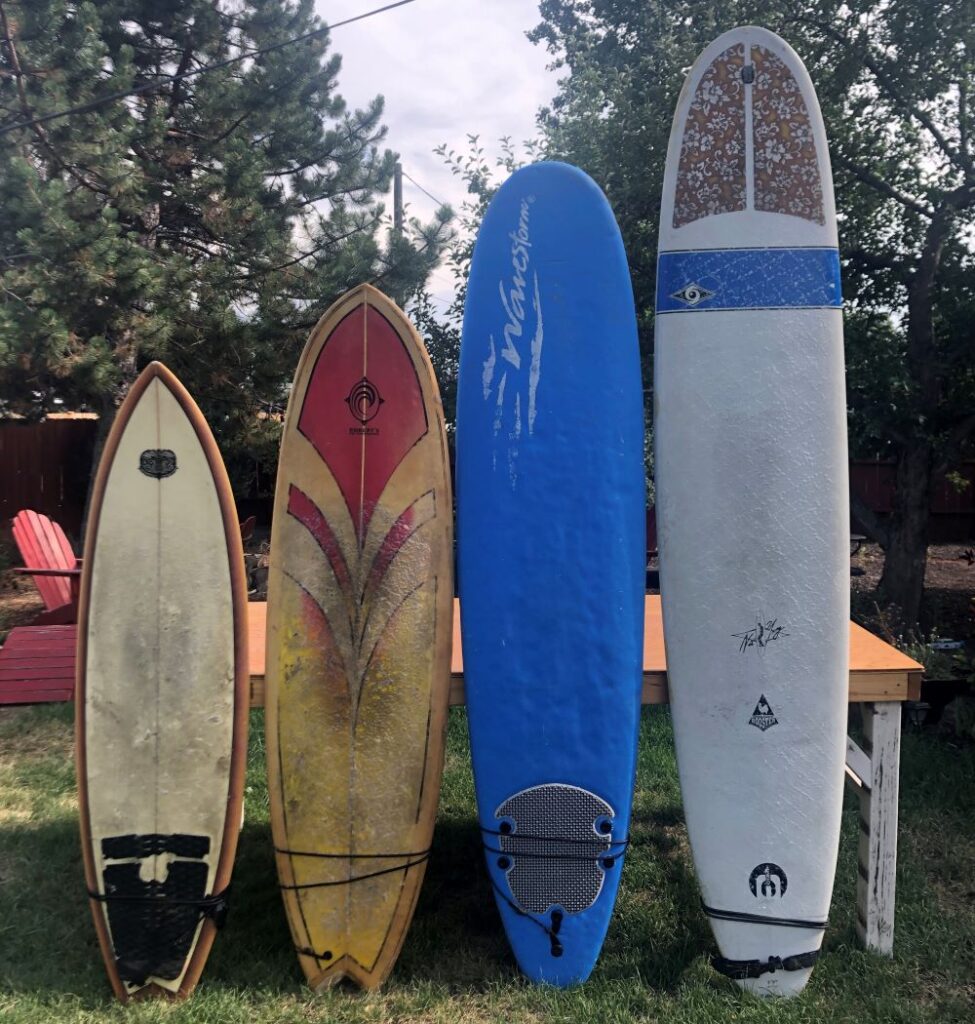
If you are a beginner or on a budget, then it is a great option to buy a used surfboard. Even if you could afford a new board, a used board is usually sufficient for most people. Therefore, I recommend buying a used surfboard if you are new to surfing or want to save money.
However, if you have some money to spend and don’t want to waste time shopping second-hand, check out the best longboard surfboards you can buy online.
2. Determine what kind of surfboard you want
Whether you choose to buy a used surfboard or a new one, you will have to decide the type of board that you want.

Surfboards come in many styles, shapes, and sizes. The length, width, thickness, weight, nose shape, tail shape, number of fins, and other parameters will change from one surfboard to another. Unfortunately, it can feel overwhelming for beginners to choose the right board.
Generally, larger boards (meaning longer, wider, and thicker) are easier to ride. I recommend beginners purchase a longboard compared to a short or mid-length board. Learn more about how to choose a surfboard for beginners.
Soft-top vs PU vs Epoxy surfboards
You need to know the difference between foam, epoxy, and PU surfboards. All three common surfboard types are quite different, and understanding the main differences are important when buying a used surfboard.
In short, PU surfboards (aka fiberglass surfboards) are more traditional construction. They are heavier, generally more affordable, and more fragile. Epoxy surfboards are usually more durable, lighter, and more expensive. Both are better in different ways. Before you proceed here, check out my article about the different types of surfboard materials.
If you have your eyes on a hard-top surfboard, but not sure if it is PU or epoxy, learn how to tell the difference.
Fortunately, all types of surfboards can be found used, including longboards, so it shouldn’t be too hard to find a suitable board for your needs.
3. Find a surfboard
Once you have decided on the general type of surfboard you want, you can start shopping. Yipee! Fortunately, there are lots of different places to find a used surfboard.
a. Online Forums and Websites
Online forums and websites are great resources to find used surfboards. Forums include Craigslist, Facebook Marketplace, and Ebay. Websites like secondhandboards.com are also options.
I’ve personally bought four used surfboards from Craigslist or Facebook Marketplace. Also, my dad got a great deal on some nice longboards from someone on Craigslist.
If you are patient, you can find great deals, even if it might not be exactly the style of surfboard you are looking for. For example, people often are moving and need to sell their board quickly.
I recommend only purchasing a used surfboard if you can go see it in person. This way, you can inspect the board closely for damage, which is important (more on this later). It is easy to hide damage in photos. Also, the surfboard can be damaged in shipping.
b. Surf Shops
Surf shops will often have used surfboards for sale. Although you may not find as good of a deal as Craigslist or Facebook Marketplace, the surfboards are generally good quality, because the employees check them for damage.
Even if a surf shop doesn’t have an official used board section, you can always ask the employees if they have any used surfboards you can buy. You might be surprised!
c. Outdoor Gear Shops
Some shops that sell a wide range of used outdoor gear will have a surfboard to two every once and a while.
In fact, just the other day, I saw a used surfboard from a used gear shop in Bend, Oregon, 3.5 hours from the coast. You can give the shop a call and ask ahead of time.
d. Garage Sales
Oh, garage sales. Browsing other people’s crap can be an enjoyable warm-weather pastime indeed. Garage sales can also yield extremely good deals on surfboards if you’re lucky.
My dad found a board for $14 and I used it for years before reselling it for $80. It was roughed up but functional, which was exactly what I needed. Plus, garage sales are fun even if they don’t have a surfboard!
4. Ask questions
So you have your eye on a board and you are thinking about pulling the trigger. Before you do, you’ll want to ask some questions to learn more about the surfboard.
Quick aside – Like any meeting with a stranger, make sure you do it safely. Here are some general guidelines:
- Meet in a public place
- Go to the meeting location with a friend or family member
- If you can’t, tell people where and when you are going. Maybe call a friend during the encounter
- Call the seller ahead of time to get a sense of the person’s character
- Try to spot any sort of spam or misleading information in the online posting
- Trust your gut
Ask questions about the quality and history of the board, as well the reason it is being sold. See some example questions below:
- Why are you selling the board?
- What is the brand?
- You can look up the make online to get an idea for quality/fair price.
- What is the board made out of?
- Another parameter that determines the performance and therefore the price
- How long have you owned the board?
- Did you buy it new or used?
- Do you like riding it and in what conditions?
- Is it water tight?
- Is there any damage?
- You can ask about any specific type of damage in the list below
- Have you made any repairs?
- Professional repairs are a good sign, but DIY repairs may not be water tight
- Does the board come with a leash and fins?
- Are the fins removable?
5. Check for quality/damage
After you ask questions to get a feel for the board and the history, inspect the board for damage. I mean really inspect it. Get your eyes and hands on every inch of the surfboard. Pro tip: bring a flashlight when you go to look at it.
Boards naturally get damaged over time, and it is expected for a used board to have some repairs or other unsightly characteristics. However, the important thing is that it is watertight. A board that has leaks won’t last long because the foam will become waterlogged and degrade.
The following list of types of damage below mostly applies to epoxy and PU boards. Foam boards are generally much more durable and won’t need to be inspected quite so thoroughly.
Keep in mind: minor damages can be repaired yourself with some basic materials and a few YouTube videos. More significant damages can be repaired professionally, but the cost of professional repairs may outweigh the cost benefit of the used board.
Check the board for each of the following damage types:
Pressure dings
Pressure dings are small indents where something has pressed into the board. They are one of the most common types of damage for a used surfboard to have.
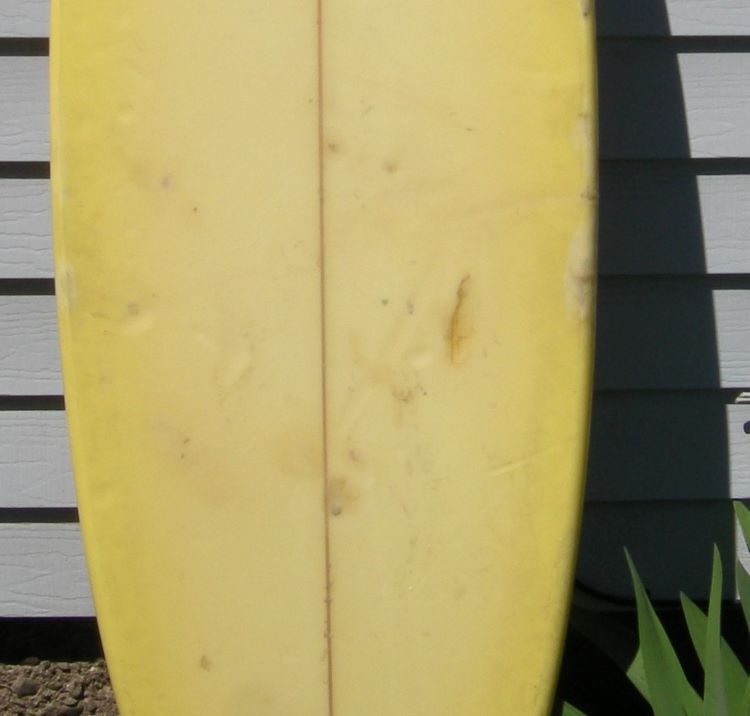
Pressure dings are most very common in PU boards. Epoxy boards are more durable and don’t get pressure dings as easily, but it is still possible
Pressure dings, or just dings, can happen as easily as pressing your thumb into the board too hard (PU boards) or knocking your board into a hand railing too hard.
Sometimes, these dings are still watertight and don’t compromise the integrity of the board. Other times, they are deep enough or large enough that they are not watertight. They can usually be repaired quite easily in this case.
Chips and Punctures
Chips or punctures can happen when a sharp object impacts the board. Most of the time, a chip or puncture is no longer watertight and must be repaired. Even if you can tell the PU or epoxy is not fully compromised, it’s probably smart to repair the damage.
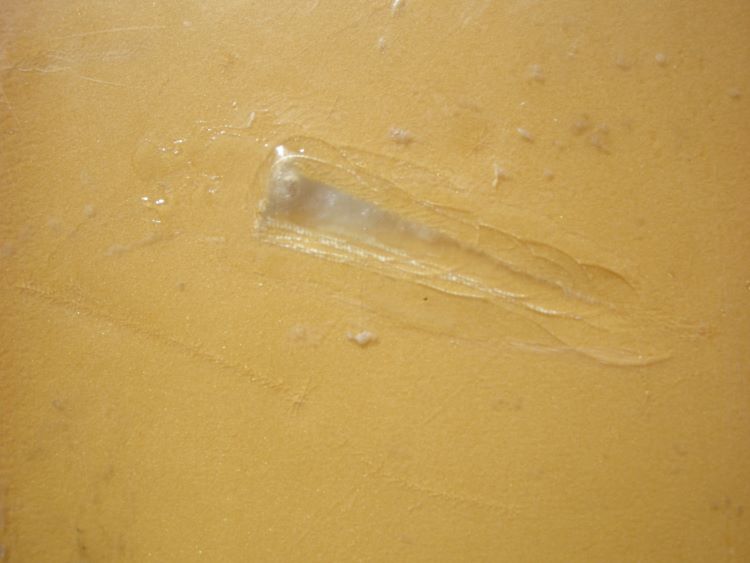
As far as repairing chips and punctures goes, it’s usually not a tough fix. A basic surfboard repair kit will do the trick in most cases.
Therefore, chips and punctures are not deal breakers. But they can definitely be negotiating points. Don’t be afraid to point them out to the seller!
Cracking/Splitting
Sometimes cracks may develop as a result of blunt impact or even pressure on both sides of the board. Typically, cracks are likely to appear around the rails, tail, or nose of the board.
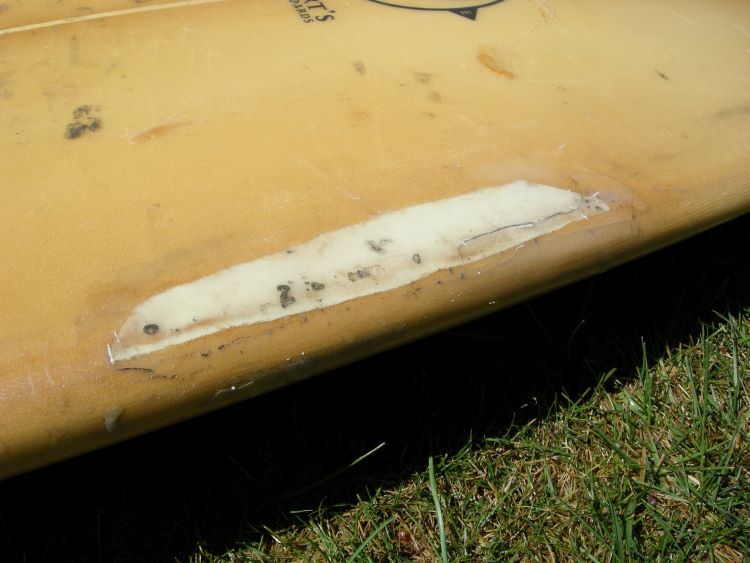
Cracks are usually not watertight and will need to be repaired. The severity of the crack will dictate how intense the repair will need to be. It is usually more difficult to repair a crack than a puncture because they are typically larger and in more challenging locations on the board.
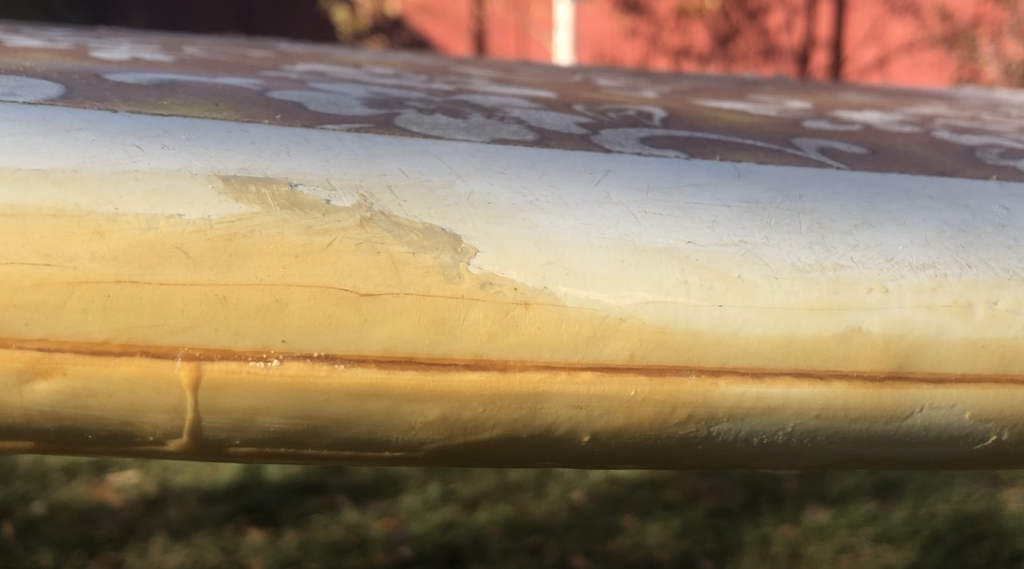
Epoxy surfboards are sometimes manufactured in two halves and pressed together with machinery. The resulting seams may separate over time. Keep an eye out for seam splitting on epoxy surfboards.
Buckling
Buckling is when the board is fully or partially folded. Fortunately, this issue is usually fairly easy to spot and will appear as a crease or line across the board, typically running rail to rail (short ways). In my opinion, buckling should always be a deal breaker, even though it may be able to be repaired professionally.
Buckling severely undermines the structural integrity of the board and you should avoid a board that looks even remotely like it has a crease or fold.
Fin box
The base of the fins, where they attach to the board, is a hot spot for damage. After all, the fins are being pushed side to side (hopefully by water and not by sand) and this pressure can damage the board itself.
First check if the board has a fin box or is “glassed in”. A fin box means the fins can be removed and replaced. Glassed in means the fins are merged with the board directly with fiberglass.
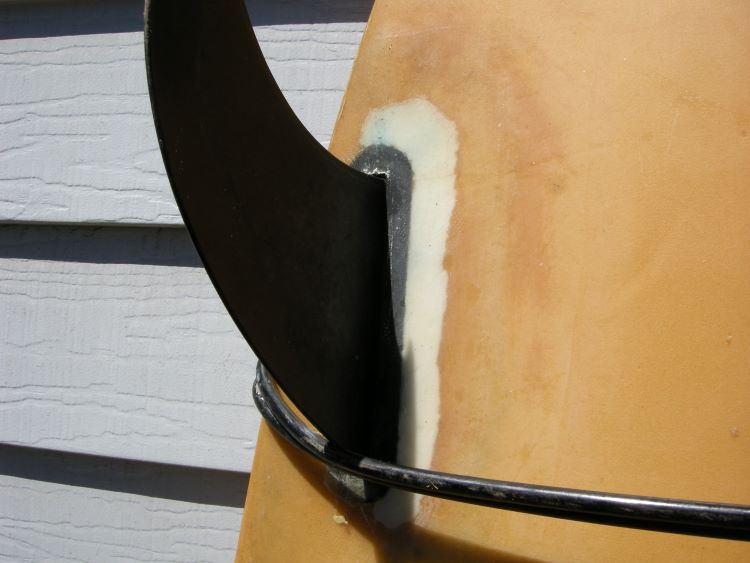
Check the area around the base of the fins for cracks or clear damage. A few small cracks are normal, but it should look watertight.
Delamination
Delamination is when the fiberglass or epoxy separates from the foam, creating a bubble. This issue can be minor and insignificant or major and something to be considered further.
You may want to pass if there is an obvious bubble that can be pressed down and up with your fingers. Try to feel how large the bubble is. If it is over a few inches long in any direction, you should be getting a good deal on the board or walking away.
Yellowing
Yellowing is fairly normal for an older or used surfboard. Sunlight is bad for surfboards and can cause yellowing, but it isn’t really an issue other than how it looks.

The top layer of the board can become discolored because of the sun’s powerful UV radiation. Depending on the specific material of the board, this may happen faster or slower. The foam underneath the outer layer can also turn yellow because of the sun.
However, yellowing that is local to a specific spot on the surfboard can indicate water damage. Look for areas of yellowing with punctures or other damages right in the middle of the yellowing.
Other than wet foam as a result of damage, yellowing isn’t really something to worry about. Sometimes, you will see an area that has been damaged and the foam is yellowed, but the damage has been patched and is now water tight. Most of the used boards you find will have some yellowing.
Wax
More often than not, used boards will have a lot of old wax all over them. There’s nothing wrong with the wax itself, but the wax can make it difficult to see damage.
It’s probably too much to ask the seller to remove the wax themselves, but just be aware that wax can cover up the damage.
In reality, the wax isn’t too hard to remove. If you do purchase a board with old wax on it, you can remove it yourself and then put new wax on. Read more about how to remove old wax from a surfboard.
Stickers, paint, and other cover-ups
Be wary of any stickers or paint on the board. These cover ups are an easy way to hide damage. While I’d like to think most people wouldn’t purposely hide damage to get a better price, you can never be too careful.

6. Negotiate
Now that you have a full picture of the history and condition of the board, you can make an educated decision on whether or not you want to purchase it.
If you decide to purchase it, you can try to negotiate and get a better price. The more damage present on the surfboard, the more negotiating power you have. If the board is newer and in better condition, you won’t have much leverage.
While you’re inspecting the condition, verbally state any damage you see to the seller, and make them aware that you see the damage. Use any damages you see as negotiating points and try to talk down the price. Don’t be afraid to barter.
7. Know when to walk away
No matter what, don’t hesitate to walk away at any point in the process. There will always be more opportunities. I know it can be easy to be drawn in, but don’t fall into the fear of missing out or trying to satisfy the seller.
Buying something directly from a stranger can feel intimidating, and negotiating the price is usually uncomfortable. But remember, you can walk away at any moment. It’s better to regret not buying a surfboard than regret buying one.
8. Bring your board home
If you make the decision to buy a used surfboard, make sure you have a way to get it home! Get yourself a rack or make sure it fits in the back of your car. Congratulations! Enjoy your new (used) board. Learn how to surf and put that surfboard to good use.
Heads up! Surfing is awesome but it can be dangerous! Learn more about how to stay safe and avoid dangers while surfing. If you are a beginner surfer, check out my other articles about surfing and my ultimate guide to learning how to surf.


![Best longboard surfboards [2023] – all skill levels surfer with surf hat](https://mindfulladventure.com/wp-content/uploads/2022/10/surf-hat-crop-1000-270x180.jpeg)




